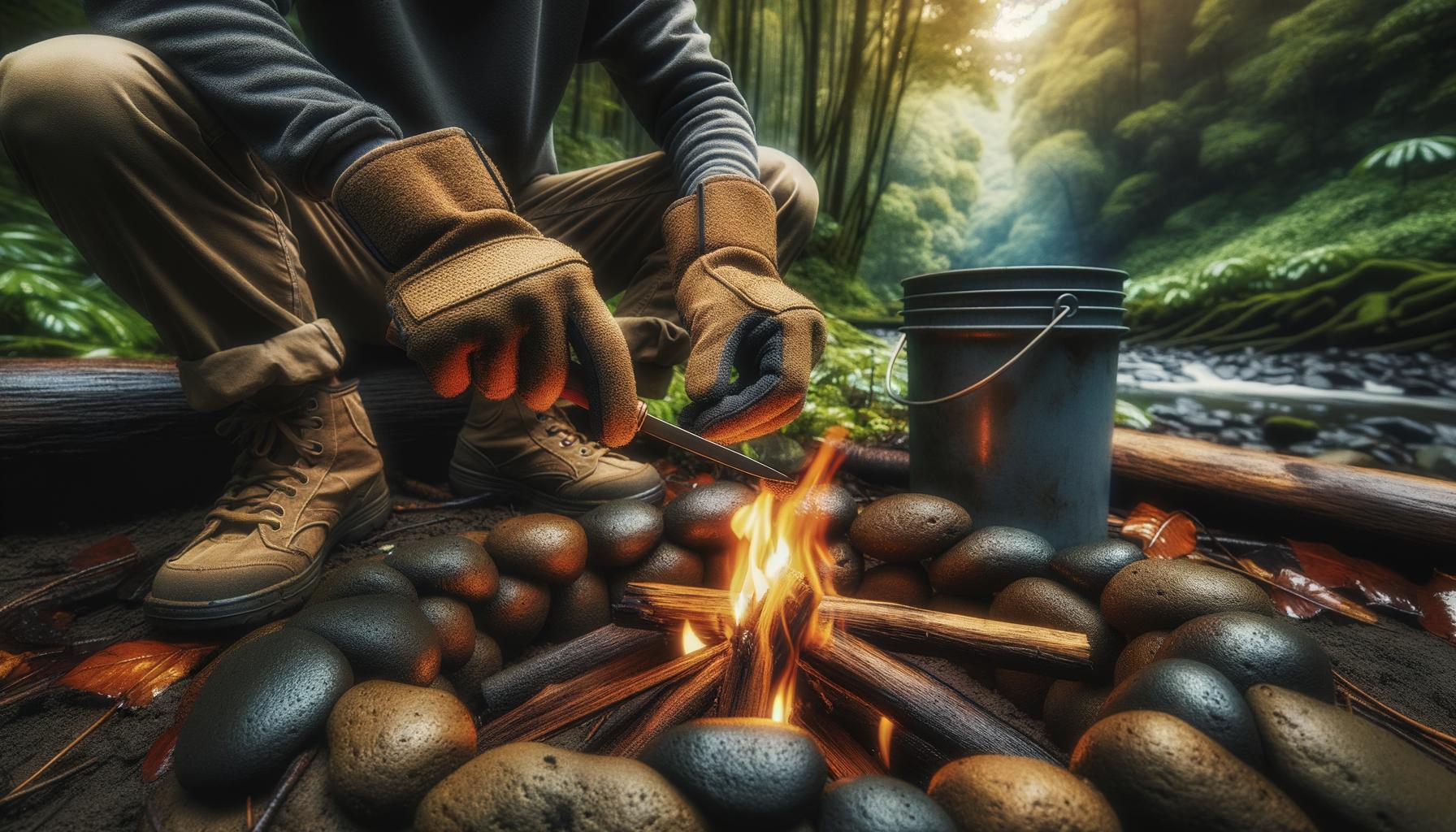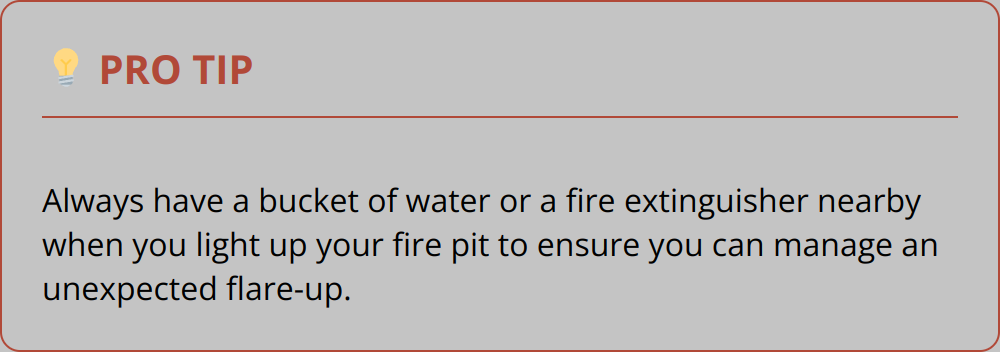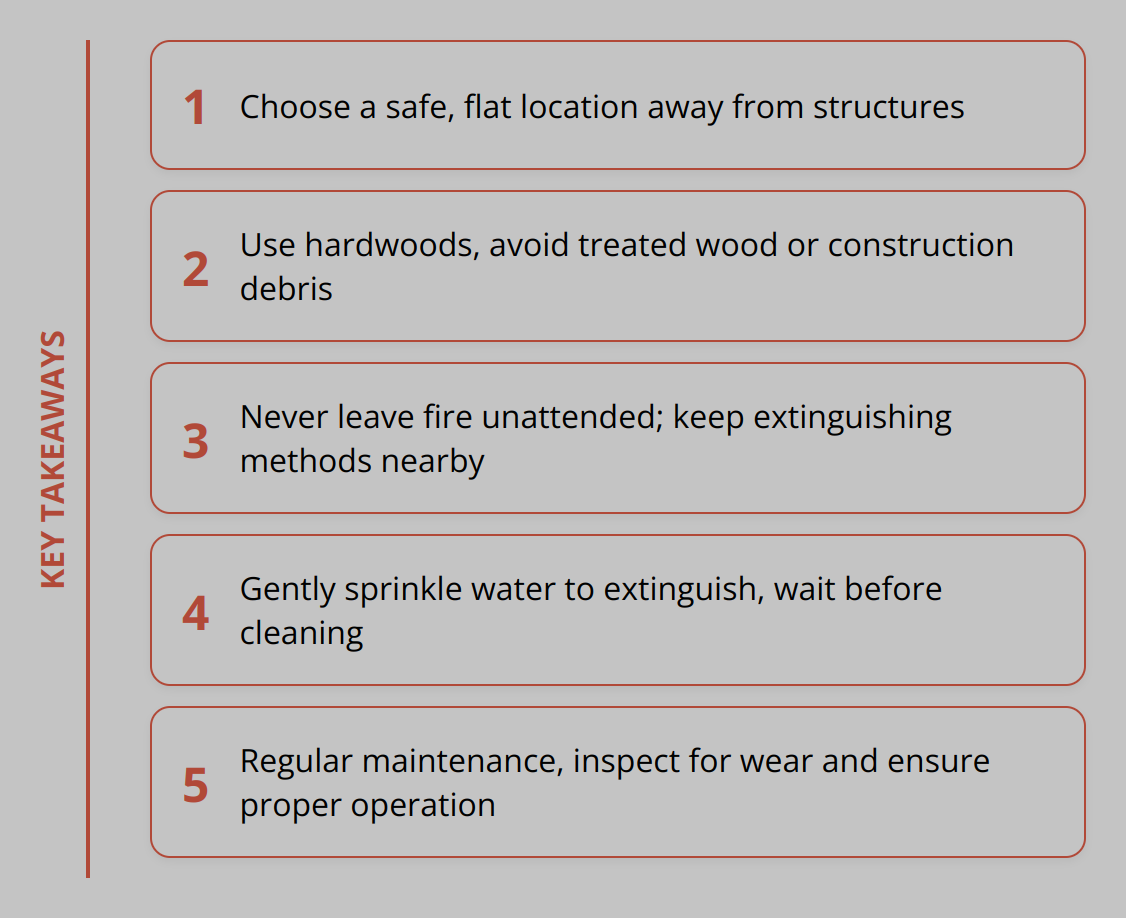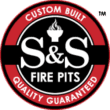
At S&S Fire Pits, we believe in the magic of gathering around a warm, crackling fire pit. However, safety should always be at the forefront of any outdoor fire experience.
In this blog post, we’ll guide you through essential safety tips and best practices to ensure your fire pit gatherings are both memorable and secure. Let’s create safe, enjoyable outdoor moments together.
Preparing Your Fire Pit Area
When it comes to enjoying a fire pit safely, the setup is as important as the event itself. A well-prepared area minimizes risks and enhances your outdoor experience. Here’s how to prepare your fire pit area with safety first.
The Importance of Location
Selecting the right spot for your fire pit cannot be overstated. Avoid areas under trees, near bushes, or close to structures; these can catch fire from rising sparks. Ideally, your fire pit should be at least 10 feet away from your home, sheds, fences, and other structures. Also, don’t forget to check wind direction and place your pit accordingly to prevent smoke and embers from becoming a nuisance or hazard.
Ground Prep and Surrounding Safety
The surface on which you place your fire pit needs to be flat and non-flammable. Concrete, bricks, or stone can provide a sturdy and safe foundation. If you’re using a portable fire pit on grass or wooden decks, consider using a protective barrier or a specially designed fire pit pad to prevent heat damage and reduce fire risk.
Surrounding your fire pit area with non-flammable materials is also wise. Gravel or stone can serve as an effective buffer zone, reducing the chance of fire spreading to unintended areas. Make sure to remove any dry leaves, twigs, or other potential fuel from around the pit to keep the fire contained where it belongs.
Choose the Right Fuel
Not all fuels are created equal when it comes to fire pits. Hardwoods like oak or hickory are excellent choices as they burn cleaner and longer than softwoods. Avoid using treated wood, construction debris, or yard waste as these can release harmful chemicals when burned. If you’re using a gas fire pit, ensure all connections are secure and leak-free to prevent accidents. Proper fuel selection and maintenance not only keep the fire burning efficiently but also significantly reduce the risk of unwanted flare-ups or toxic smoke.

.
Always remember, safety is paramount when enjoying a fire in your outdoor space. By carefully selecting your fire pit’s location, preparing the ground and surroundings, and using the right fuel, you can ensure a safe and pleasant experience for everyone involved. For more details on making your outdoor living space more welcoming with a fire pit, check our tips on creating the perfect area for a fire pit.
Safe Fire Pit Operation
Operating a fire pit safely is key to ensuring a memorable and hazard-free gathering. This goes beyond just lighting the fire; it involves vigilant monitoring and correct extinguishing methods. Below are actionable tips to keep your fire experiences enjoyable and, most importantly, safe.
Lighting the Fire Pit Correctly
Starting your fire the right way sets the tone for a controlled and safe burn. Always use a recommended fire starter; never resort to gasoline or other flammable liquids, as this can lead to uncontrollable flames or explosions. For wood-burning pits, using crumpled paper and small kindling is a safe way to start your fire. Make sure the fire catches slowly and naturally. For gas fire pits, ensure the gas flow is moderate before lighting to avoid a sudden flare-up.
- Use appropriate fire starters
- Avoid flammable liquids
- Start with small kindling
Keeping the Fire Under Control
Once your fire is lit, never leave it unattended. A sudden gust of wind can spread flames to unwanted areas, turning a cozy night into a disaster. If your fire pit comes with a screen, use it to prevent sparks from flying out. Additionally, keeping a bucket of water or a garden hose nearby is a wise precaution in case the fire begins to escape control. Make it a point to educate all guests, especially children, about maintaining a safe distance from the fire.
- Never leave fire unattended
- Keep water or a hose handy
- Use a fire screen to contain sparks
Extinguishing the Fire
Putting out the fire properly is just as crucial as how you start it. Let the fire die down naturally instead of adding more fuel towards the end of the evening. Once the flames have subsided, gently sprinkle water over the embers to cool them down — never douse suddenly, as this can create steam and hot ash. Stir the ashes to ensure all embers have been soaked. For gas fire pits, turn off the gas supply and allow the unit to cool before covering it. It’s vital to wait until the pit is completely cool before attempting to move it or dispose of the ashes.
- Let the fire die down naturally
- Sprinkle water gently on embers
- Wait for the pit to cool before cleaning

The difference between a memorable night and an unfortunate incident often lies in the details of how a fire pit is operated. Adhering to these practical guidelines will ensure that the warmth and ambiance of your fire pit can be enjoyed safely time and again. For more information on fire pit safety and maintenance, you can refer to our detailed guide on how to light a proper fire in your fire pit.
Enhancing Fire Safety
Safety around a fire pit extends beyond just supervision and correct extinguishing. It involves proactive measures to ensure everyone can enjoy the fire pit without any risks. Taking steps to install protective equipment, keep extinguishing methods nearby, and conduct regular maintenance can significantly mitigate any potential hazards associated with outdoor fires.
Protective Equipment Is Key
One of the most effective ways to enhance safety is by installing fire shields and guards around your fire pit. These not only block wayward sparks from escaping but also serve as a physical barrier to prevent accidental contact with the fire. Especially if you have children or pets, a guard or shield is essential for keeping them at a safe distance. Consider materials that withstand high temperatures and are resistant to rust for longevity.
Maintaining easy access to several extinguishing methods is not negotiable. A fire can escalate quickly; being prepared can make all the difference. Always have a fire extinguisher rated for class A fires, which includes wood, cloth, paper, and plastic, within reach. A bucket of sand can effectively smother flames without the steam and ash produced by using water. For more on choosing the right extinguisher, check the guidelines on fire pit safety tips.

Regular Check-ups Prevent Disasters
Regular maintenance and inspection of your fire pit are crucial for sustaining its safety and functionality. This includes checking for any signs of wear and tear, ensuring gas fire pits are free from leaks, and that all components are operating correctly. Keep an eye out for rust or corrosion in metal parts, and replace any damaged components immediately. For wood-burning fire pits, removing ash and debris after each use prevents buildup that could catch fire unexpectedly.
To further understand how to care for your fire pit and avoid common mistakes, exploring topics like proper fire pit maintenance can provide valuable insights and practical advice.

By embracing these measures and integrating them into your regular fire pit routine, you not only guarantee the safety of your family and guests but also ensure that your fire pit remains a cherished feature of your outdoor living space for years to come.
Final Thoughts
Our journey through the essential safety tips for enjoying fire pits has highlighted the importance of careful preparation, operation, and maintenance. From selecting the right location and fuel to correctly lighting and extinguishing the fire, every step plays a crucial role in maintaining safety. Protective measures such as fire shields and regular maintenance ensure that the cozy ambiance of a fire pit does not turn into a hazardous situation.

Safety precautions cannot be overlooked. They are the backbone of memorable and secure gatherings around the fire. By following these guidelines, you can prevent accidents and protect your loved ones. Moreover, embracing responsible use of fire pits underlines the respect we must have towards fire and its power.
We urge everyone to adopt these practices, not just for compliance but as a commitment to safety and well-being. Let’s ensure that every fire pit experience is safe, enjoyable, and leaves lasting positive memories.
At S&S Fire Pits, we take pride in offering high-quality, durable fire pits that can enhance any outdoor living space. We encourage you to explore our range of handcrafted, solid steel fire pits and lifestyle accessories. With a focus on quality and innovation, we aim to make your outdoor moments unforgettable and safe. Check out our collection and discover the perfect addition to your backyard at S&S Fire Pits.
Stay safe, and let the warmth of good company and a beautiful fire pit fill your evenings with joy and serenity.


